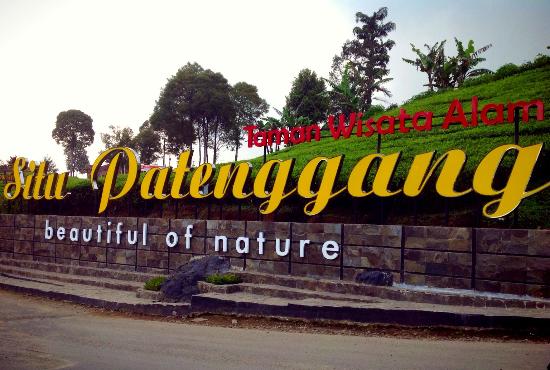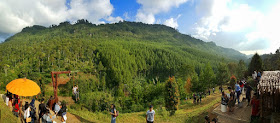Patenggang Lake (Indonesian: Situ Patenggang) is a lake located in the area of natural tourist attractions in the southern Bandung city, West Java, Indonesia, to be exact it is in Ciwidey village. Located at an altitude of 1600 meters above sea level, this lake has a very exotic landscape.
Originally, this lake is called Situ Patengan by the local society. Since the pronunciation of patengan is too difficult to say in Sundanese, then they call it Situ Patenggang or Patenggang Lake.
 |
| Patenggang Lake Bandung - Ciwidey - West Java |
One of the leading resorts is located in less than an hour by road to the south of the city. The eastern side of the lake is a cool forest has an average temperature of 10 degrees C and is often hazy the whole day. A lush tea estate, reaching far out to the west and south, borders the north side. From Cimanggu Hot Spring it is just 30 minutes drive through tea plantations. This is a lovely site for boating, the lake looks a green carpet, and tea plantations surround the lake. Patengan Lake is a very popular spot for Indonesians on a Sunday and public holiday. Its location is in Ciwidey tourism area, 47 kilometers from Bandung to the South, and the site is in the area of Rancabali tea plantation. The tourism site is good for family as it offers hot spring water swimming pool, restaurants, a recreation park for kids, and bungalow as well as other supporting facilities.
 |
| Wonderful land Patenggang Lake |
To enjoy the tourist boats have facilities that can be rented for around a small island at the end of the lake is named Sasuka Island. This island seems shady with many tall trees that grow in it. While there are locations across the lake is quite interesting that given the name Stone Love is said to believe will provide the continuity of love for the couple who came to visit the location.
Lake Patenggang History or myth about the lake surface caused by a prince’s nephew, King Siliwangi, Ki Santang and a beautiful daughter, distant mountains, goddess Rengganis who fell in love. But they do not travel as smooth as love and beautiful as that envisioned by both as separated by circumstances. So that their tears formed a lake. Later the lake was named Situ Patenggang taken from Sundanese language. In the end they can be together again on a stone there is a stone called love.


































